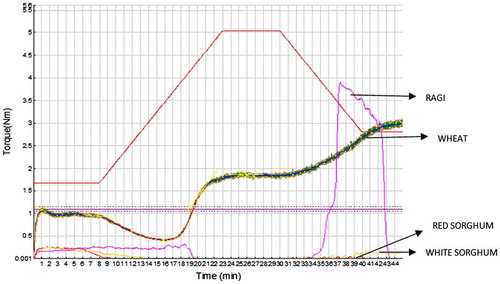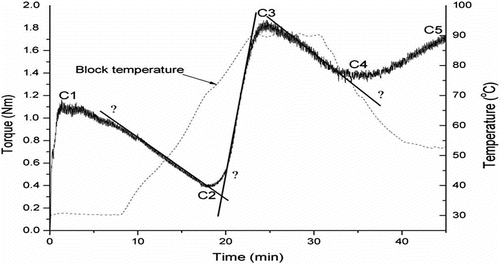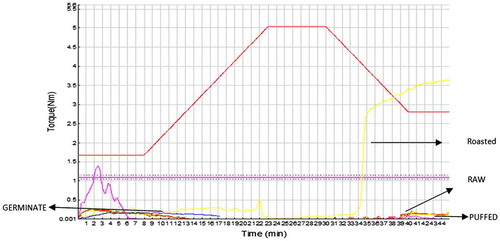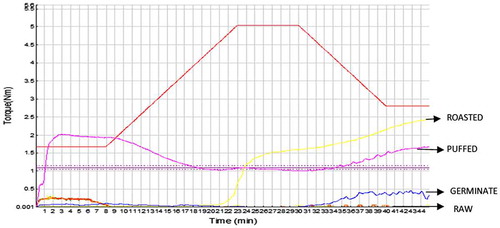Abstract
This study was undertaken to determine the effect of different treatments such as roasting, puffing and germination of white sorghum, red sorghum and ragi grains on physicochemical, antioxidant, protein, amylose, bulk density, colour index and rheological properties of respective flour. In case of ragi, after roasting treatment, total phenolic content (TPC) content for flour was increased from 0.331 ± 0.001 to 0.373 ± 0.004 mg of gallic acid equivalents per gram of dry sample. However, total flavonoids content was also increased slightly after different processing treatments. The rheological properties of respective flour were studied using Chopin Mixolab, where wheat flour dough profile acts as a reference to study the effect of different treatments. Dough elasticity which is expressed by the values of amplitude (Nm) was found to be low in case of untreated flour as compared to wheat flour dough. Elasticity values of untreated flour such as white sorghum, red sorghum and ragi were 0.02, 0.00 and 0.06 Nm, respectively. Whereas, after processing treatments, values of elasticity for roasted flour dough of white sorghum, puffed flour dough of red sorghum and roasted flour dough of ragi increased to 0.36, 0.11 and 0.15 Nm, respectively, as compared to wheat flour dough of 0.10 Nm. The results found that roasted ragi flour had higher rate of starch gelatinization, lower starch retrogradation, high antioxidant and amylose contents which were found to be prospective ingredients in whole wheat flour in various baked and fermented food applications.
Public Interest Statement
These traditional grains contain many valuable components that have several potential health benefits. These research outcomes may conclude the processing effects and benefits for the utilization of these underutilized nutritionally rich grains in daily diet. This information explores the opportunity for the development of new values added and novel functional food products for the benefits and well-being of the society.
Competing interests
The authors declare no competing interest.
1. Introduction
Wheat is one of the most common cereals used in the world for bread making. However, wheat contains gluten which causes celiac disease. Hence, due to greater public awareness of celiac disease and gluten intolerance, wheat flour is fully or partially replaced with flour from other cereals. Being gluten-free cereals, sorghum and finger millet can serve as alternatives to wheat to curb the increasing occurrence of celiac disease (Kulamarva, Sosle, & Raghavan, Citation2009).
Starch is the major storage form of carbohydrate in sorghum and millets. The digestibility of sorghum starch can be increased by various processes such as steaming, pressure cooking, flaking, puffing or micronization. Niba and Hoffman (Citation2003) reported that sorghum being a potential source of resistant starch and β-glucans can be utilized as a prebiotic food ingredient in value-added food products. Processed sorghum has been successfully used in the preparation of porridges, baked products, extruded snacks, chapatti (unleavened flat bread), pasta products (Kulamarva et al., Citation2009; Taylor, Schober, & Bean, Citation2006) and expanded snacks (Jadhav & Annapure, Citation2013). Sorghum and ragi grains are rich sources of various phytochemicals including phenolics, tannic acid, anthocyanins, phytosterols and policosanols, and therefore used in food and various other applications (Awika, Rooney, & Waniska, Citation2005). The protein content is higher among these grains and is equivalent to that of wheat and maize.
Different treatments such as roasting and puffing can be employed to improve the overall palatability (Özdemir & Devres, Citation2000), flavour, texture and nutritional value of grains (Mridula, Goyal, Bhargav, & Manikantan, Citation2007). Roasting and puffing being dry heat processes reduce the rate of enzymatic activity (lipase) and increase the shelf-life of the product by lowering the water activity (Severini, Gomes, De Pilli, & Romani, Citation2000). A few reports available on puffing of sorghum revealed that sorghum expands very well when subjected to high temperature and short time treatment. Reduction in phytic acid and increase in minerals’ solubility in foods can be achieved by wet processing including germination. These processes thus could improve the bioavailability of minerals in cereals.
However, substitution of wheat flour with flour from other raw materials will alter the rheological properties of dough, as well as the features of a baked product. It is well known that proteins present in non-wheat flour are deficient in the ability to form the gluten network responsible for holding the gas produced during the fermentation (Arendt, O’Brien, Schober, Gallagher, & Gormley, Citation2002; Gallagher, Gormley, & Arendt, Citation2003) process.
In many studies, among different rheological techniques, Mixolab has been likely used for probing dough behaviour during processing conditions (Collar, Bollaín, & Rosell, Citation2007; Huang et al., Citation2010; Rosell, Collar, & Haros, Citation2007). The objective of this study is to investigate the effect of different treatments like roasting, puffing and germination on the rheological behaviour of sorghum and ragi during mixing and heating using Mixolab.
2. Materials and methods
2.1. Materials
The wheat flour of white sorghum grains was procured from the local market of Palampur (India), whereas ragi grains were from a market of the western Himalayan region (Lahaul and Spiti). Raw material was cleaned to remove broken grains and other extraneous materials. These grains were roasted, puffed, germinated and further ground to powder in order to study their rheological properties.
2.2. Processing treatments
For roasting, 100-g raw grains were placed in an open pan and roasted using a hot plate for 2–3 min with continuous stirring. Then, roasted seeds were cooled and pulverized to fine particles and stored at room temperature for further analysis.
For puffing, 50-g raw grains were puffed for 3 min in a small electric air puffer (SOFTEL, Smart Snacker, India). The puffed grains were separated from the husk, milled and stored at room temperature for further analysis.
For germination, 100-g soaked grains were placed in a steel tray, covered with cotton cloth and left at room temperature for 72 h. The germinated grains were dried and pulverized to fine particles and kept at room temperature for further analysis.
2.3. Physicochemical properties
Raw and processed flour of white sorghum, red sorghum and ragi were analysed as per the standard methods. Moisture and ash content were determined by Association of Official Analytical Chemists (Citation2002) methods. Water holding capacity (WHC) was determined according to the method used by Robertson et al. (Citation2000) and was calculated on a dry basis percentage. Protein content was estimated by using standard Lowry’s method. Bulk density of the samples was calculated by measuring mass and volume. It was determined by weighing the quantity of selected length of pieces required to fill a 100-ml beaker (Hood-Niefer & Tyler, Citation2010). Colour value (L*, a* and b*) analysis was performed using a reflectance colorimeter (CR 400, Konica Minolta, USA). Amylose content of the samples was determined using the method of Williams, Kuzina, and Hlynka (Citation1970). A starch sample (20 mg) was taken and 10 ml of 0.5 N KOH was added to it. The suspension was thoroughly mixed. Then, the sample was transferred to a 100-ml volumetric flask and made the final volume to the mark with distilled water. Ten millilitres of test starch solution were pipetted out into a 50-ml volumetric flask and 5 ml of 0.1 N HCl was added followed by 0.5 ml of iodine reagent. The volume was diluted to 50 ml and the absorbance (A) was measured at 625 nm. For each analysis, triplicates were used.
2.4. Antioxidant properties
Total phenolic content of both the flour sample and the extruded product of white sorghum, red sorghum and ragi was determined using Folin–Ciocalteu reagent method (Li & Zhang, Citation2001). About 0.5 ml of Folin–Ciocalteu (0.5 N) was added to 0.1 ml of sample. The mixture was swirled and allowed to stand for 15 min followed by the addition of 2.5 ml of saturated sodium carbonate and samples were mixed. Solutions were allowed to stand for 30 min at room temperature and the absorbance was read at 765 nm wavelength using a spectrophotometer. Total flavonoids content (TFC) was determined in both flour sample and the extruded product using aluminium chloride method (Chang, Lin, Chuang, & Chiang, Citation1996). The results were expressed as mg of quercetin equivalents per gram of dry sample. All determinations were performed in triplicate.
2.5. Rheological measurements
Mixolab was used to investigate the rheological properties of the dough during the process of mixing at constant temperature and during the period of constant heating and cooling. Mixolab software was used to calculate the amount of flour required for analysis, taking flour moisture and water absorption input values into consideration. Rheological behaviour of different raw materials was determined by chopin Mixolab, using chopin+ protocol. The whole test can be divided into five different stages: dough development, protein denaturation, starch gelatinization, amylase activity and starch retrogradation. Different stages recorded in the Mioxolab plot are shown in Figure .
Water absorption (%) represents the amount of water that is required to produce the dough with a consistency of 1.1 ± 0.07 Nm (point C1). The dough development time is the time measured from initial dough mixing until the C1 point is reached. The dough development time is directly proportional to strength of the flour. Stability (min) represents the resistance of the dough to the applied mixing forces (time during the measurement when the dough consistency is not lower than 11% of value of torque at C1 point). Higher the resistance, stronger the dough. The elasticity of the dough is represented by the width of the curve at C1 point, also called amplitude (Nm). Higher the amplitude, more elastic the dough. During dough mixing, on increasing the temperature and applied force, the protein structure weakens. The rate of weakening is determined by slope α. The value C2 represents the minimum torque recorded during the period of mixing and increasing the system temperature. This value is also dependent on the protein structure characteristics. Slope β represents the rate of starch gelatinization, while the values of maximum viscosity correspond to the value of the maximum torque at the point C3, representing gelling ability of starch. Enzymatic degradation of starch and its rate are indicated by the slope γ. Value of the C4 point which is second minimum in the recorded curve shows the stability of hot paste. Starch retrogradation is measured at the end of the cooling period at point C5 (CHOPIN, Citation2006).
3. Results and discussion
The effect of roasting, puffing and germination on the physicochemical properties of white sorghum, red sorghum and ragi was investigated on dry weight basis as shown in Tables –. The results revealed that there was a significant increase in the crude protein content of the processed flour when compared with raw samples. In case of red sorghum and ragi flour, highest increase in protein content was observed due to puffing, i.e. 0.139 ± 0.014 and 0.034 ± 0.001, respectively (Tables and ). The lowest protein content observed in roasted red sorghum might be due to the thermal destruction of amino acids (Mauron, Citation1982). However, on comparing treated samples of white sorghum with raw sample, a significant decrease in protein content was observed as shown in Table .
Table 1. Physicochemical analysis of white sorghum flour
Table 2. Physicochemical analysis of red sorghum flour
Table 3. Physicochemical analysis of ragi flour
The antioxidant properties, i.e. total phenolic content and flavanoid content, were increased due to roasting of all concerned grains as compared to flour from raw grains, while significant decrease was observed in case of germination. In case of ragi, observed TPC value for raw flour is 0.331 ± 0.001, while after the roasting treatment, the observed value for treated flour is 0.373 ± 0.004 (Table ). The antioxidative properties of flavonoids were due to several mechanisms, such as scavenging of free radicals, chelating of metal ions, such as iron and copper, and inhibition of enzymes responsible for free radical generation (Benavente-García, Castillo, Marin, Ortuño, & Del Río, Citation1997). Decrease in antioxidant factors during germination might be attributed to the leaching of polyphenols while soaked in water (Jood, Chauhan, & Kapoor, Citation1987) and increased enzymatic treatment during germination (Bishnoi, Khetarpaul, & Yadav, Citation1994).
In case of ragi, a significant increase in amylose content was observed due to roasting treatment. As shown in Tables –, moisture content observed in raw flour was more as compared to the treated flour. WHC observed after puffing in white sorghum, red sorghum and ragi was 258.02, 348.52 and 363.25%, respectively, which was highest as compared to other treatments. Density and colour index were observed lowest in puffed flour as compared to other treated flour.
The wheat and non-wheat flour (white sorghum, red sorghum and ragi) were characterized in terms of protein quality and thermo mechanical behaviour using Mixolab device. Using this method, it is possible to record the mechanical changes due to mixing and heating. It also simulates the mechanical work as well as the heat conditions that might be expected during the bread-making and bread-baking processes. The advantage of using Mixolab is that in a single test one can measure the properties of proteins, starch and associated enzymes. The main derived parameters from Mixolab curves are presented in Tables –. Water absorption, dough development time, stability and mechanical weakening are parameters which refer to the dough characteristics during mixing at a constant temperature, 30°C, describing the dough behaviour during the processing stage. Wheat flour dough, which served as a control sample, was characterized with long stability and great resistance to mechanical constrain. These properties of wheat flour are related to its unique protein composition and quality. The obtained Mixolab profiles of wheat flour as well as the non-wheat flour are presented in Figure .
Table 4. Mixolab measurements of the systems containing wheat flour and white sorghum flour
Table 5. Mixolab measurements of the systems containing red sorghum flour
Table 6. Mixolab measurements of the systems containing ragi flour
Figure 2. Mixolab profiles of raw wheat flour, raw white sorghum, raw red sorghum and raw ragi flour

After observing the first part of the curve, which mainly depends on the physical characteristics of protein matrix, it can be seen that by replacing the wheat flour with other flour will result in a weaker protein network. Proteins of non-wheat raw flour have smaller water absorption for that reason than those flour in comparison with wheat flour need more time to achieve maximum torque during mixing at 30°C (C1) also called dough development time. The development time is related to the time necessary to hydrate all the compounds. Maximum torque (C1) for wheat dough was 1.09, while for the dough of white sorghum, red sorghum and ragi was 0.25, 0.26 and 0.33, respectively (Tables –). By treating the sorghum and ragi grains with roasting and puffing, there was an increase in the C1 value as compared to raw flour, shown in Figures –. This effect might be related to the high WHC of this protein (Vose, Citation1980), limiting the water availability for the rest of the components. Some treatments, like germination, did not have an impact on the strength of protein complex as compared to roasting and puffing in non-wheat flour.
The dough elasticity expressed by the values of amplitude (Nm) was higher for flour treated with roasting, germinating and puffing in comparison to their respective raw flour and almost same as that of raw wheat flour. Elasticity for wheat dough was 0.10, while for the dough of roasted white sorghum, puffed red sorghum and roasted ragi flour was 0.36, 0.11 and 0.15, respectively (Tables –).
Sorghum and ragi flour expressed significantly lower value of minimum torque C2 compared to pure wheat flour system. This was the consequence of dilution of wheat gluten complex and inability of sorghum and ragi flour to form dough with similar physical characteristics due to the different protein compositions of these flour. On the contrary, C2 value increased with the puffing treatment.
Second part of the curve follows the changes in dough structure caused by the increase in temperature and mechanical forces of mixing. These changes are mainly influenced by starch and enzymatic characteristics present in the flour system. From the resulted slope β, it can be concluded that the highest rate of starch gelatinization was shown by wheat flour dough, which also had the maximum value of torque at the point C3 (Table ). The replacement of wheat flour with white and red sorghum flour resulted in a decrease of gelatinization rate and lowered the value of maximum torque at point C3. Low value of torque at point C3 might be a consequence of the nature of starch present in sorghum and the milling process. These two factors might be responsible for causing larger amount of damaged starch having poorer pasting properties. Dough of roasted white sorghum and puffed red sorghum had higher value of maximum torque at point C3 (Tables and ).
The degree of starch retrogradation, which can be expressed as a difference between measured torques at C4 and C5, is also called setback torque. This value is lower in case of sorghum and ragi as compared to wheat flour. For the wheat dough, the setback torque was 1.16, while for the dough of white and red sorghum and ragi flour was 0.06, 0.01 and −3.29, respectively. This may have a positive effect on bread-stailing effect, which is proved to be due to starch retrogradation. It is assumed that the reason for such behaviour arises from different structures of amylose and amylopectin fractions of sorghum and ragi in comparison to wheat starch (different ratio between amylose and amylopectin, branching of these polymers and their molecular weight).
Furthermore, if we see Figures – and compare the effect of different treatments on the flour, the maximum increase in the set-back temperature occurs due to roasting in case of red sorghum and ragi, while in case of white sorghum, germination had positive effects. The same effect of roasting on rheology of sorghum flour was also found by others (Ranganathan, Nunjundiah, & Bhattacharya, Citation2013).
4. Conclusion
White sorghum, red sorghum and ragi flour were tested in order to investigate their abilities in comparison with wheat flour dough behaviour. After comparison, it was concluded that untreated flour samples had different rheological profiles from wheat flour, but after treatments, samples exhibited similar and constant protein (water absorption, stabilities and degree of mechanical weakening) and starch (setback torque) behaviour in the Mixolab. The nutritional properties like protein, ash, moisture, TPC, TFC and WHC of raw material were also not much affected during roasting, puffing and germination. To conclude, although to imitate wheat flour unique rheological properties is a challenging task, it is possible to create comparable rheological behaviour with improved functional properties using roasted ragi flour as a substitute.
Additional information
Funding
Notes on contributors
Mahesh Gupta
Our group is working on novel food processing for new product development from traditional and nutritionally rich Himalayan bioresources, particularly focusing on biochemical characterization and innovative functional food ingredients’ formulation. The developed formulations were further assessed for in vivo and in vitro model systems for various health benefit claims.
References
- Arendt, E. K. , O’Brien, T. J. , Schober, T. J. , Gallagher, E. , & Gormley, T. R. (2002). Development of gluten-free cereal products. Farm Food , 12 , 21–27.
- Association of Official Analytical Chemists . (2002). Official methods of analysis (16th ed., pp. 15–211). Washington, DC: Author.
- Awika, J. M. , Rooney, L. W. , & Waniska, R. D. (2005). Anthocyanins from black sorghum and their antioxidant properties. Food Chemistry , 90 , 293–301.10.1016/j.foodchem.2004.03.058
- Benavente-García, O. , Castillo, J. , Marin, F. R. , Ortuño, A. , & Del Río, J. A. (1997). Uses and properties of citrus flavonoids. Journal of Agricultural and Food Chemistry , 45 , 4505–4515.10.1021/jf970373s
- Bishnoi, S. , Khetarpaul, N. , & Yadav, R. K. (1994). Effect of domestic processing and cooking methods on phytic acid and polyphenol contents of pea cultivars (Pisum sativum). Plant Foods for Human Nutrition , 45 , 381–388.10.1007/BF01088088
- Chang, W. S. , Lin, C. C. , Chuang, S. C. , & Chiang, H. C. (1996). Superoxide anion scavenging effect of coumarins. The American Journal of Chinese Medicine , 24 , 11–17.10.1142/S0192415X96000037
- CHOPIN Applications Laboratory . (2006). Mixolab applications handbook, rheological and enzymatic analysis . Villeneuve la Ga-renne: Author.
- Collar, C. , Bollaín, C. , & Rosell, C. M. (2007). Rheological behaviour of formulated bread doughs during mixing and heating. Journal of Food Science and Technology , 13 , 99–107.
- Gallagher, E. , Gormley, T. R. , & Arendt, E. K. (2003). Crust and crumb characteristics of gluten free breads. Journal of Food Engineering , 56 , 153–161.10.1016/S0260-8774(02)00244-3
- Hood-Niefer, S. D. , & Tyler, R. T. (2010). Effect of protein, moisture content and barrel temperature on the physicochemical characteristics of pea flour extrudates. Food Research International , 43 , 659–663.10.1016/j.foodres.2009.09.033
- Huang, W. , Li, L. , Wang, F. , Wan, J. , Tilley, M. , & Ren, C. (2010). Effects of transglutaminase on the rheological and Mixolab thermomechanical characteristics of oat dough. Food Chemistry , 121 , 934–939.10.1016/j.foodchem.2010.01.008
- Jadhav, M. V. , & Annapure, U. S. (2013). Effect of extrusion process parameters and particle size of sorghum flour on expanded snacks prepared using different varieties of sorghum (Sorghum bicolour L.). Journal of Agricultural Science and Technology B , 3 , 71–85.
- Jood, S. , Chauhan, B. M. , & Kapoor, A. C. (1987). Polyphenols of chickpea and blackgram as affected by domestic processing and cooking methods. Journal of the Science of Food and Agriculture , 39 , 145–149.10.1002/(ISSN)1097-0010
- Kulamarva, A. , Sosle, V. R. , & Raghavan, G. S. V. (2009). Nutritional and rheological properties of sorghum. International Journal of Food Properties , 12 , 55–69.10.1080/10942910802252148
- Li, S. Q. , & Zhang Q. H. (2001). Advances in the development of functional foods from buckwheat. Critical Reviews in Food Science and Nutrition , 41 , 451–464.10.1080/20014091091887
- Mauron, J. (1982). Effect of processing on nutritive value of food protein. Handbook of Nutritive Value of Processed Foods , 1 , 429–471.
- Mridula, D. , Goyal, R. K. , Bhargav, V. K. , & Manikantan, M. R. (2007). Effect of roasting on texture, color and acceptability of soybean for making sattu. American Journal of Food Technology , 2 , 265–272.
- Niba, L. L. & Hoffman, J. (2003). Resistant starch and β-glucan levels in grain sorghum (Sorghum bicolor M.) are influenced by soaking and autoclaving. Food Chemistry , 81 , 113–118.10.1016/S0308-8146(02)00386-2
- Özdemir, M. , & Devres, O. (2000). Analysis of color development during roasting of hazelnuts using response surface methodology. Journal of Food Engineering , 45 , 17–24.10.1016/S0260-8774(00)00036-4
- Ranganathan, V. , Nunjundiah, I. T. , & Bhattacharya, S. (2013). Effect of roasting on rheological and functional properties of sorghum flour. Journal of Food Science and Technology International , 20 , 579–589.
- Robertson, J. A. , de Monredon, F. D. , Dysseler, P. , Guillon, F. , Amado, R. , & Thibault, J. F. (2000). Hydration properties of dietary fibre and resistant starch: A European collaborative study. LWT - Food Science and Technology , 33 , 72–79.10.1006/fstl.1999.0595
- Rosell, C. M. , Collar, C. , & Haros, M. (2007). Assessment of hydrocolloid effects on the thermo mechanical properties of wheat using the Mixolab. Food Hydrocolloids , 21 , 452–462.10.1016/j.foodhyd.2006.05.004
- Severini, C. , Gomes, T. , De Pilli, T. , & Romani, S. (2000). Autoxidation of packed almonds as affected by Maillard reaction volatile compounds derived from roasting. Journal of Agricultural and Food Chemistry , 48 , 4635–4640.10.1021/jf0000575
- Taylor, J. R. N. , Schober, T. J. , & Bean, S. R. (2006). Novel food and non-food uses for sorghum and millets. Journal of Cereal Science , 44 , 252–271.10.1016/j.jcs.2006.06.009
- Vose, J. R. (1980). Production and functionality of starches and protein isolates from legume seeds (field pea and horsebeans). Cereal Chemistry , 57 , 406–410.
- Williams, P. C. , Kuzina, F. D. , & Hlynka, L. (1970). A rapid calorimetric procedure for estimating the amylose content of starches and flour. Cereal Chemistry , 47 , 411–421.




